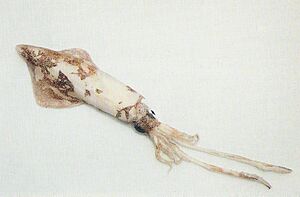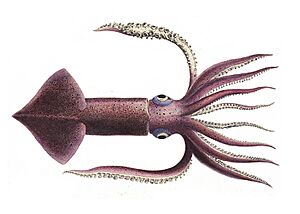European flying squid facts for kids
Quick facts for kids European flying squid |
|
|---|---|
 |
|
| Conservation status | |
| Scientific classification | |
| Synonyms | |
|
The European flying squid (Todarodes sagittatus) is a type of squid that lives in the deep waters of the eastern Atlantic Ocean and the Mediterranean Sea. It's a well-known species and is often caught by fishing boats, though sometimes by accident.
Contents
What Does the European Flying Squid Look Like?
The European flying squid is a large squid. The biggest one ever found was about 75 centimeters (nearly 30 inches) long, measured from its head to the tip of its body. Males can grow up to 64 centimeters (about 25 inches). Most of these squids are usually between 25 and 35 centimeters long.
They have a long, strong body called a mantle. At the end of their body, they have wide, strong fins that help them swim. These fins are about 45% of their body length.
Their arms are thin and more than twice as long as their head. The suckers on their arms have a large tooth in the middle and several smaller teeth. They don't have any special light-producing organs inside their bodies. The males have a special arm, usually the fourth one on the right, which is used for reproduction. This arm has modified suckers that look like fleshy bumps. These squids are usually a dark purplish color.
Where Do European Flying Squids Live?
You can find the European flying squid in the eastern Atlantic Ocean. Their home stretches from Greenland and Iceland all the way to the Arctic waters of Russia. They also live in the North Sea, the Mediterranean Sea, and the Sea of Marmara. They can be found as far south as the Gulf of Guinea.
Squid Homes and Habits
The European flying squid is an oceanic species. This means they live in the open ocean, not just near the coast. They can be found from the surface down to depths of over 1,000 meters (about 3,300 feet). Some have even been found as deep as 4,595 meters (over 15,000 feet) in UK waters! Sometimes, they are seen near the seabed on the continental shelf, especially off the coast of northwest Africa.
Amazing Migrations
These squids travel long distances to find food and to grow up. In the North Atlantic, large groups of them appear near Iceland, the Faroe Islands, Norway, and Scotland in early summer. They stay in these areas until winter arrives. It's quite common to see many of these squids washed up on the shore in these places during summer. When winter comes, they move to deeper waters further offshore. Squids living in warmer areas, like off the coast of northwest Africa and in the western Mediterranean, tend to stay in one place more.
Daily Dives and Social Life
Around Madeira and other parts of the eastern central Atlantic, many European flying squids are seen from March to May. Here, they also move from shallower areas to deeper waters as they grow. These squids also make daily vertical migrations. This means they are found near the seabed or in deep waters during the day. At night, they move up closer to the surface. However, some squids are still caught in deep waters at night, suggesting not all of them move up.
Squids of this species can be found alone or in small groups. But as they travel to find food, they form large schools. These big groups are seen on the continental shelves in the northern Atlantic and off northwest Africa.
Life Cycle and Reproduction
Most of the European flying squids caught are females. Very few males are captured. This might be because males and females live in different areas for feeding and only meet to reproduce. Males might stay in the breeding areas, living deeper and not moving up to feed daily. Males also become mature at a smaller size and younger age than females. Generally, the biggest squids are found in cooler waters.
These squids likely reproduce all year round in deep waters. However, there are peak times for spawning, especially in late winter or early spring in the northeastern Atlantic. In the western Mediterranean, spawning is most common between September and November. Females can lay hundreds of thousands of eggs, depending on their size. They lay eggs in batches, and the number of eggs in each batch decreases over time. Spawning happens in depths between 200 and 800 meters (about 650 to 2,600 feet), usually near the bottom.
Young squids, called Paralarvae, are carried by ocean currents. They live in the upper layers of the water, usually between 50 and 150 meters deep. They grow very quickly when they are young. Scientists believe their entire life cycle takes just over a year. However, larger squids (over 50 centimeters long) might live for 18 months to two years.
What Do They Eat?
The European flying squid eats fish, crustaceans (like crabs and shrimp), and other cephalopods (like other squids and octopuses). In the northern parts of their range, they mainly eat small Atlantic herring and Atlantic cod. Other studies show they also eat fish like blue whiting and herring. They also eat deep-sea fish, crustaceans, and other squids. They sometimes even eat other European flying squids! Off the Macaronesian Islands, lanternfish are their favorite food.
Who Eats the Squid?
Many ocean predators eat the European flying squid. These include large fish like tuna and swordfish, as well as sharks, seals, and cetaceans (like dolphins and whales). This squid is an important food source for some dolphin species. It's also an important host for certain parasites called Anisakid nematodes, which are intestinal worms.
Squids and People: Fishing and Conservation
The European flying squid is mostly caught by accident when fishing boats are trying to catch other species. However, it is also fished on purpose using methods like jigging (using a special lure) and purse seining (using a large net that closes like a purse). In southern Italy, both commercial and recreational fishermen target this squid in the summer.
People eat the squid fresh or boiled. It can also be frozen, salted, or dried for later use. Fishermen also use it as bait to catch fish like cod and halibut.
There are no specific rules for managing the fishing of this squid. The total population is made up of several groups that live in different places. The number of squids can change over time depending on the environment. Since the late 1900s, the average catch has been about 3,000 tonnes per year, though this number has varied a lot. The largest catches were recorded between 1981 and 1985. In Europe, this squid is often caught with other types of squids, and sometimes the exact species isn't identified. Over 25 years, up to 2014, there wasn't a clear trend in their numbers. Because of this, scientists consider the European flying squid to be of "least concern" for conservation.
In Italy, this squid has its own special name, totano. Other types of squids are usually called calamari.




